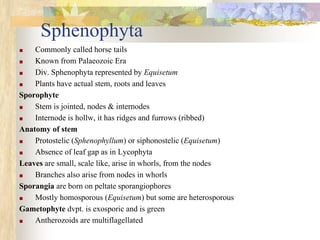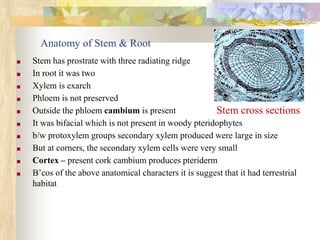Jacob thomas mar_thoma_college_tiruvalla_
- 1. Dr. Jacob Thomas Asst. Professor in Botany Mar Thoma College, Tiruvalla Seedless Vascular Plants
- 2. Sphenophyllum Ō¢Ā Division ŌĆō Sphenophyta Ō¢Ā Class ŌĆō Sphenophyllopsida Ō¢Ā Order ŌĆō Sphenophyllales
- 3. Sphenophyta Ō¢Ā Commonly called horse tails Ō¢Ā Known from Palaeozoic Era Ō¢Ā Div. Sphenophyta represented by Equisetum Ō¢Ā Plants have actual stem, roots and leaves Sporophyte Ō¢Ā Stem is jointed, nodes & internodes Ō¢Ā Internode is hollw, it has ridges and furrows (ribbed) Anatomy of stem Ō¢Ā Protostelic (Sphenophyllum) or siphonostelic (Equisetum) Ō¢Ā Absence of leaf gap as in Lycophyta Leaves are small, scale like, arise in whorls, from the nodes Ō¢Ā Branches also arise from nodes in whorls Sporangia are born on peltate sporangiophores Ō¢Ā Mostly homosporous (Equisetum) but some are heterosporous Gametophyte dvpt. is exosporic and is green Ō¢Ā Antherozoids are multiflagellated
- 4. Sphenophyllales Ō¢Ā Originated in the upper Devonian Ō¢Ā Reach climax during Carboniferous & lower Permian Ō¢Ā Disappeared in lower Triassic Ō¢Ā Stem is very delicate Ō¢Ā Stem & roots showing secondary thickening Ō¢Ā Leaves usually multiples of three present in each nodes & sessile Ō¢Ā Strobili are contain whorls of appendages differentiated into sporangiphores & bracts Ō¢Ā Either homo or heterosporous Ō¢Ā Represented by a single genus Sphenophyullum
- 5. Sphenophyllum Ō¢Ā About 50 spp. Ō¢Ā Sphenophyllum speciosum from Lower Gondwana of India (Ramiganch series) Ō¢Ā Morphology suggests that it was a prostrate trailer with a partial aquatic Ō¢Ā But anatomy suggests that it had a terrestrial habitat and probably it may a climber Ō¢Ā The ribs were not alternate as in Equisetum, but it was continuous Ō¢Ā Leaves were heterophyllous ŌĆō this suggest that it had an aquatic habitat Ō¢Ā But heterophyllous leaves were intermingled (it shows a doubtful habitat) Ō¢Ā Dichotomously veined leaves suggest the megaphyllous nature Ō¢Ā So it was mistaken that it was a fern leaf Ō¢Ā Roots ŌĆō true, arise in whorls from the nodes, adventitious
- 6. Compressions and permineralizations of Sphenophyllum show a node/internode arrangement with whorls of wedge-shaped leaves
- 7. Anatomy of Stem & Root Ō¢Ā Stem has prostrate with three radiating ridge Ō¢Ā In root it was two Ō¢Ā Xylem is exarch Ō¢Ā Phloem is not preserved Ō¢Ā Outside the phloem cambium is present Ō¢Ā It was bifacial which is not present in woody pteridophytes Ō¢Ā b/w protoxylem groups secondary xylem produced were large in size Ō¢Ā But at corners, the secondary xylem cells were very small Ō¢Ā Cortex ŌĆō present cork cambium produces pteriderm Ō¢Ā BŌĆÖcos of the above anatomical characters it is suggest that it had terrestrial habitat Stem cross sections
- 8. Reproduction Ō¢Ā The vegetative parts of many fossils of Sphenophyllum show similarity, the cones of many species are different Ō¢Ā So the reproductive structures in Sphenophyllales grouped in different ŌĆśform familiesŌĆÖ and Genera Ō¢Ā Family 1. Sphenophyllaceae Genera 1. Sphenophyllostachys (Bowmanites) 2. Peltastrobus 3. Sphenostrobus 4. Lithostrobus Ō¢Ā Family 2. Cheirostrobaceae 1. Cheirostrobus Ō¢Ā Family 3. Tristachyaceae 1. Tristachya Ō¢Ā Family 4. Eviostachyiaceae 1. Eviostachys (Eviostachya)
- 9. Sphenophyllostachys (Bowmanites) Ō¢Ā About 31 species are found S. dowsonii Ō¢Ā It is a small cone ŌĆō 1cm in diameter Ō¢Ā Strobilus has main axis Ō¢Ā Nodes and internodes Ō¢Ā Each nodes have sterile and fertile appendages Ō¢Ā Sterile appendages is whorl of bracts Ō¢Ā Bracts and sporangiophores are arranged in multiples of three Ō¢Ā Bracts were fused to form a cup like structure Ō¢Ā Each bracts bears a sporangiophore Ō¢Ā These sporangiophores get branched at tip Ō¢Ā And each branch of the sporangiophores carry one reflexed sporangium Ō¢Ā The branching is of two types Ō¢Ā In some it has a short median arm and two long side-branches Ō¢Ā Others have two short median arms and a long distal arm
- 10. Sphenophyllostachys reomeri Ō¢ĀSimiliar to that S. dowsonii except that each sporangiophore carried two reflexed sporangia S. acquensis Ō¢ĀIs the simplest of the cone Ō¢ĀWhere at each node a whorl of free bracts are present and each bract has a single sporangiophore with a single sporangium at their tips S. majus Ō¢ĀHere the bract at a node is forked or dichotomised and at the axil of each bract, a sporangiophore, each having 4 reflexed sporangia at their tips S. fertilis Ō¢ĀIt is a much complicated cone which was found detached from the vegetative parts Ō¢ĀBut bŌĆÖcos of the triarch arrangement of the wood in the axis they are assumed to that belong to members of Sphenophyllum Ō¢ĀThe cone is made up of six superimposed whorls of sporangiophores at each nodes Ō¢ĀEach sporangiophore at a node is subtended by a pair of bracts Ō¢ĀEach sporangiophore terminated in a group of branches which is about 16 in number and each branching bearing two sporangia
- 11. Eviostachya Ō¢ĀEach cone had at its base a whorl of 6 bracts, above which there where whorls of sporangiophores which were 6 in number Ō¢ĀEach sporangiophore divided in a characteristic way Ō¢ĀIt was trichotomously divided into three and each branch is again divided into 9, with the middle branch shorter Ō¢ĀEach branch ends in a sporangia and all together each sporangiophores carry a total number of 27 reflexed sporangia and spinous projections from sporangiophores where present Ō¢ĀEach sporangiophore stood vertically above each other which is characteristic of Sphenophyllales Ō¢ĀBut there were no bracts b/w whorls of sporangia Cheirostrobus Ō¢ĀHas 36 sporangiophores in each whorl, subtended by the same number of bracts and each bract has bifurcated tip Ō¢ĀIt was obtained from Carboniferous deposits Ō¢ĀIt is the most complex of all pteridophytic fructifications, that has been described











